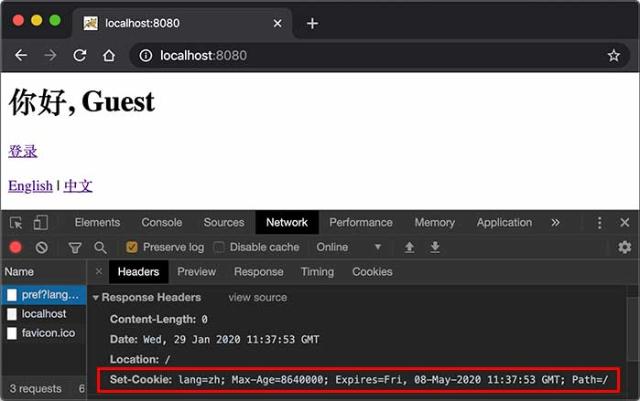使用Session和Cookie
在Web应用程序中,我们经常要跟踪用户身份。当一个用户登录成功后,如果他继续访问其他页面,Web程序如何才能识别出该用户身份?
因为HTTP协议是一个无状态协议,即Web应用程序无法区分收到的两个HTTP请求是否是同一个浏览器发出的。为了跟踪用户状态,服务器可以向浏览器分配一个唯一ID,并以Cookie的形式发送到浏览器,浏览器在后续访问时总是附带此Cookie,这样,服务器就可以识别用户身份。
Session
我们把这种基于唯一ID识别用户身份的机制称为Session。每个用户第一次访问服务器后,会自动获得一个Session ID。如果用户在一段时间内没有访问服务器,那么Session会自动失效,下次即使带着上次分配的Session ID访问,服务器也认为这是一个新用户,会分配新的Session ID。
JavaEE的Servlet机制内建了对Session的支持。我们以登录为例,当一个用户登录成功后,我们就可以把这个用户的名字放入一个HttpSession对象,以便后续访问其他页面的时候,能直接从HttpSession取出用户名:
@WebServlet(urlPatterns = "/signin")
public class SignInServlet extends HttpServlet {
// 模拟一个数据库:
private Map<String, String> users = Map.of("bob", "bob123", "alice", "alice123", "tom", "tomcat");
// GET请求时显示登录页:
protected void doGet(HttpServletRequest req, HttpServletResponse resp) throws ServletException, IOException {
resp.setContentType("text/html");
PrintWriter pw = resp.getWriter();
pw.write("<h1>Sign In</h1>");
pw.write("<form action=\"/signin\" method=\"post\">");
pw.write("<p>Username: <input name=\"username\"></p>");
pw.write("<p>Password: <input name=\"password\" type=\"password\"></p>");
pw.write("<p><button type=\"submit\">Sign In</button> <a href=\"/\">Cancel</a></p>");
pw.write("</form>");
pw.flush();
}
// POST请求时处理用户登录:
protected void doPost(HttpServletRequest req, HttpServletResponse resp) throws ServletException, IOException {
String name = req.getParameter("username");
String password = req.getParameter("password");
String expectedPassword = users.get(name.toLowerCase());
if (expectedPassword != null && expectedPassword.equals(password)) {
// 登录成功:
req.getSession().setAttribute("user", name);
resp.sendRedirect("/");
} else {
resp.sendError(HttpServletResponse.SC_FORBIDDEN);
}
}
}
上述SignInServlet在判断用户登录成功后,立刻将用户名放入当前HttpSession中:
HttpSession session = req.getSession();
session.setAttribute("user", name);
在IndexServlet中,可以从HttpSession取出用户名:
@WebServlet(urlPatterns = "/")
public class IndexServlet extends HttpServlet {
protected void doGet(HttpServletRequest req, HttpServletResponse resp) throws ServletException, IOException {
// 从HttpSession获取当前用户名:
String user = (String) req.getSession().getAttribute("user");
resp.setContentType("text/html");
resp.setCharacterEncoding("UTF-8");
resp.setHeader("X-Powered-By", "JavaEE Servlet");
PrintWriter pw = resp.getWriter();
pw.write("<h1>Welcome, " + (user != null ? user : "Guest") + "</h1>");
if (user == null) {
// 未登录,显示登录链接:
pw.write("<p><a href=\"/signin\">Sign In</a></p>");
} else {
// 已登录,显示登出链接:
pw.write("<p><a href=\"/signout\">Sign Out</a></p>");
}
pw.flush();
}
}
如果用户已登录,可以通过访问/signout登出。登出逻辑就是从HttpSession中移除用户相关信息:
@WebServlet(urlPatterns = "/signout")
public class SignOutServlet extends HttpServlet {
protected void doGet(HttpServletRequest req, HttpServletResponse resp) throws ServletException, IOException {
// 从HttpSession移除用户名:
req.getSession().removeAttribute("user");
resp.sendRedirect("/");
}
}
对于Web应用程序来说,我们总是通过HttpSession这个高级接口访问当前Session。如果要深入理解Session原理,可以认为Web服务器在内存中自动维护了一个ID到HttpSession的映射表,我们可以用下图表示:
┌ ─ ─ ─ ─ ─ ─ ─ ─ ─ ─ ─ ─ ─ ─ ─ ─ ─ ─ ─ ┐
│ ┌───────────────┐ │
┌───▶│ IndexServlet │◀──────────┐
│ │ └───────────────┘ ▼ │
┌───────┐ │ ┌───────────────┐ ┌────────┐
│Browser│──┼─┼───▶│ SignInServlet │◀────▶│Sessions││
└───────┘ │ └───────────────┘ └────────┘
│ │ ┌───────────────┐ ▲ │
└───▶│SignOutServlet │◀──────────┘
│ └───────────────┘ │
└ ─ ─ ─ ─ ─ ─ ─ ─ ─ ─ ─ ─ ─ ─ ─ ─ ─ ─ ─ ┘
而服务器识别Session的关键就是依靠一个名为JSESSIONID的Cookie。在Servlet中第一次调用req.getSession()时,Servlet容器自动创建一个Session ID,然后通过一个名为JSESSIONID的Cookie发送给浏览器:

这里要注意的几点是:
JSESSIONID是由Servlet容器自动创建的,目的是维护一个浏览器会话,它和我们的登录逻辑没有关系;- 登录和登出的业务逻辑是我们自己根据
HttpSession是否存在一个"user"的Key判断的,登出后,Session ID并不会改变; - 即使没有登录功能,仍然可以使用
HttpSession追踪用户,例如,放入一些用户配置信息等。
除了使用Cookie机制可以实现Session外,还可以通过隐藏表单、URL末尾附加ID来追踪Session。这些机制很少使用,最常用的Session机制仍然是Cookie。
使用Session时,由于服务器把所有用户的Session都存储在内存中,如果遇到内存不足的情况,就需要把部分不活动的Session序列化到磁盘上,这会大大降低服务器的运行效率,因此,放入Session的对象要小,通常我们放入一个简单的User对象就足够了:
public class User {
public long id; // 唯一标识
public String email;
public String name;
}
在使用多台服务器构成集群时,使用Session会遇到一些额外的问题。通常,多台服务器集群使用反向代理作为网站入口:
┌────────────┐
┌───▶│Web Server 1│
│ └────────────┘
┌───────┐ ┌─────────────┐ │ ┌────────────┐
│Browser│────▶│Reverse Proxy│───┼───▶│Web Server 2│
└───────┘ └─────────────┘ │ └────────────┘
│ ┌────────────┐
└───▶│Web Server 3│
└────────────┘
如果多台Web Server采用无状态集群,那么反向代理总是以轮询方式将请求依次转发给每台Web Server,这会造成一个用户在Web Server 1存储的Session信息,在Web Server 2和3上并不存在,即从Web Server 1登录后,如果后续请求被转发到Web Server 2或3,那么用户看到的仍然是未登录状态。
要解决这个问题,方案一是在所有Web Server之间进行Session复制,但这样会严重消耗网络带宽,并且,每个Web Server的内存均存储所有用户的Session,内存使用率很低。
另一个方案是采用粘滞会话(Sticky Session)机制,即反向代理在转发请求的时候,总是根据JSESSIONID的值判断,相同的JSESSIONID总是转发到固定的Web Server,但这需要反向代理的支持。
无论采用何种方案,使用Session机制,会使得Web Server的集群很难扩展,因此,Session适用于中小型Web应用程序。对于大型Web应用程序来说,通常需要避免使用Session机制。
Cookie
实际上,Servlet提供的HttpSession本质上就是通过一个名为JSESSIONID的Cookie来跟踪用户会话的。除了这个名称外,其他名称的Cookie我们可以任意使用。
如果我们想要设置一个Cookie,例如,记录用户选择的语言,可以编写一个LanguageServlet:
@WebServlet(urlPatterns = "/pref")
public class LanguageServlet extends HttpServlet {
private static final Set<String> LANGUAGES = Set.of("en", "zh");
protected void doGet(HttpServletRequest req, HttpServletResponse resp) throws ServletException, IOException {
String lang = req.getParameter("lang");
if (LANGUAGES.contains(lang)) {
// 创建一个新的Cookie:
Cookie cookie = new Cookie("lang", lang);
// 该Cookie生效的路径范围:
cookie.setPath("/");
// 该Cookie有效期:
cookie.setMaxAge(8640000); // 8640000秒=100天
// 将该Cookie添加到响应:
resp.addCookie(cookie);
}
resp.sendRedirect("/");
}
}
创建一个新Cookie时,除了指定名称和值以外,通常需要设置setPath("/"),浏览器根据此前缀决定是否发送Cookie。如果一个Cookie调用了setPath("/user/"),那么浏览器只有在请求以/user/开头的路径时才会附加此Cookie。通过setMaxAge()设置Cookie的有效期,单位为秒,最后通过resp.addCookie()把它添加到响应。
如果访问的是https网页,还需要调用setSecure(true),否则浏览器不会发送该Cookie。
因此,务必注意:浏览器在请求某个URL时,是否携带指定的Cookie,取决于Cookie是否满足以下所有要求:
- URL前缀是设置Cookie时的Path;
- Cookie在有效期内;
- Cookie设置了secure时必须以https访问。
我们可以在浏览器看到服务器发送的Cookie:

如果我们要读取Cookie,例如,在IndexServlet中,读取名为lang的Cookie以获取用户设置的语言,可以写一个方法如下:
private String parseLanguageFromCookie(HttpServletRequest req) {
// 获取请求附带的所有Cookie:
Cookie[] cookies = req.getCookies();
// 如果获取到Cookie:
if (cookies != null) {
// 循环每个Cookie:
for (Cookie cookie : cookies) {
// 如果Cookie名称为lang:
if (cookie.getName().equals("lang")) {
// 返回Cookie的值:
return cookie.getValue();
}
}
}
// 返回默认值:
return "en";
}
可见,读取Cookie主要依靠遍历HttpServletRequest附带的所有Cookie。
练习
在Servlet中使用Session和Cookie。
小结
Servlet容器提供了Session机制以跟踪用户;
默认的Session机制是以Cookie形式实现的,Cookie名称为JSESSIONID;
通过读写Cookie可以在客户端设置用户偏好等。